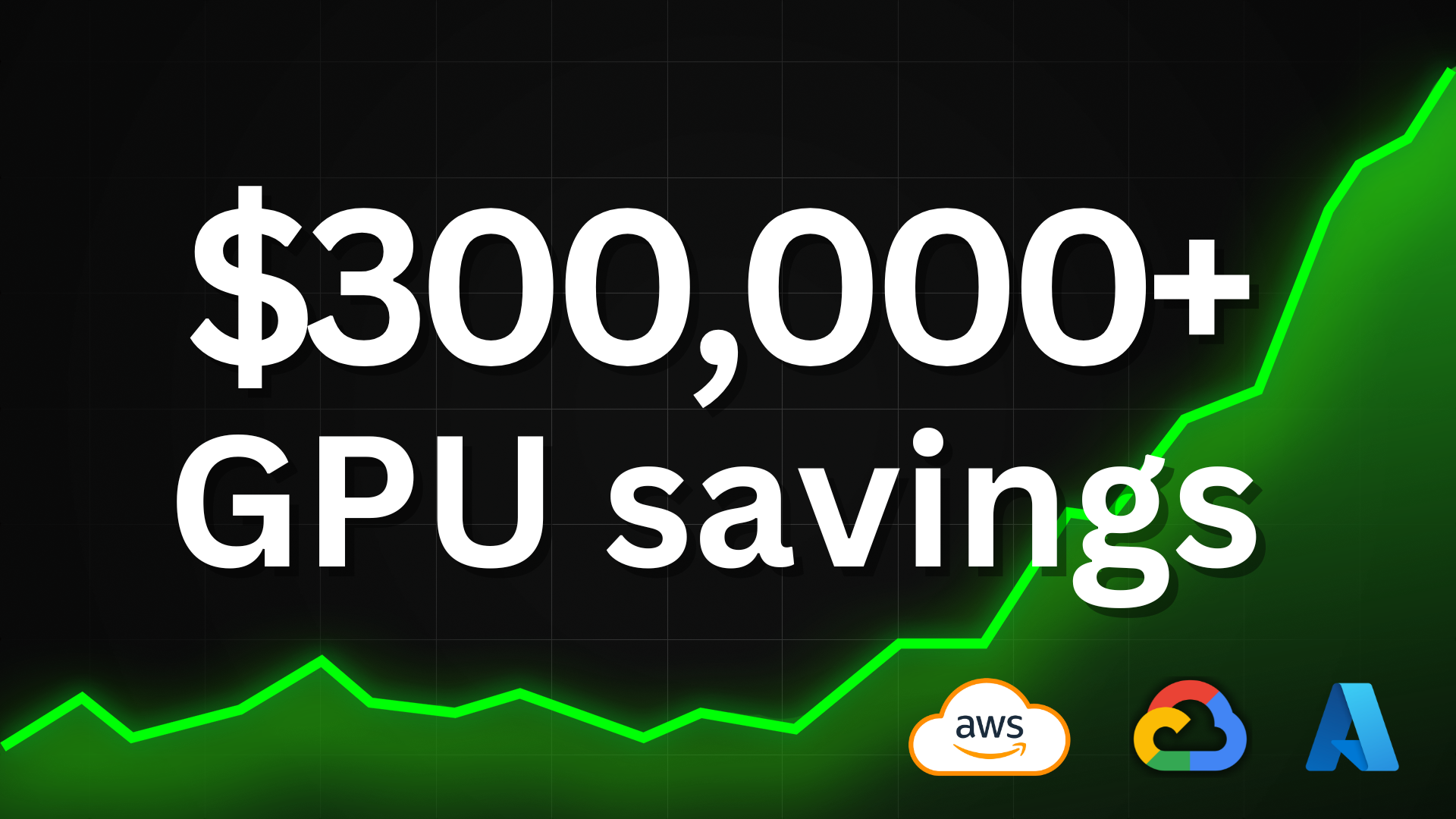- Case
- Cost Optimization
How small to mid-sized AI product companies can save $300,000+ in Cloud GPU Costs yearly

- Rapid growth could lead to cloud GPU infrastructure costs that exceed $20,000/month while revenue grows slower or is stagnant
- Managed services are easy to set up but often lead to poor GPU resource utilization (e.g. 20% average) due to inefficient resource allocation
- Major trade-off of managed services is slow cold start times that cannot efficiently handle demand peaks and spiky traffic patterns
- Using managed services (e.g. AWS Bedrock, Azure AI services, Google AI Platform): 0.2 USD/query
- Using K8s in the cloud with on-demand GPU instances with a self-hosted solution: 0.53 USD/GPUh → ~0.05 USD/query
- Using K8s in the cloud with 80/20 spot GPU instances split (80% spot, 20% on-demand) with a self-hosted solution: 0.1 USD/GPUh → ~0.008 USD/query
$427,685.68
Baseline cost
$113,336.7
↓73.5% savings($314,348.97)
$39,774.77
↓90.7% savings($387,910.91)
In comparison using K8s with on-demand GPU instances is already a good solution. The cost is approx. 73.5% lower and the growth follows more of a linear pattern.
Lastly using K8s with 80/20 spot GPU instances split is the best solution. The cost is approx. 91% lower than using managed services and the growth is linear. This results in the biggest savings and the lowest cost.
- Develop self-hosted AI solution as a replacement for the managed service
- Orchestrate automated GPU workload processing with autoscaling
- Implement cloud monitoring dashboards to track costs and performance
- Use 80/20 spot/on-demand GPU split for optimal costs
- Implement resilient spot interruption handling to avoid interruptions
- Monitor workload resource usage in real time and find parallelization opportunities.
- Iterate the development of the self-hosted solution by improving the performance with the monitoring feedback.
- Use priority-based smart autoscaling to optimize costs and performance
- Implement scale down to zero during idle periods to avoid unnecessary costs
- Create an efficient pod distribution to optimize resource utilization in multi-stage pipelines.
Suggested Implementation Process
The migration of existing AI workloads can be progressively rolled out in phases. Depending on the complexity of the AI workloads and the maturity of the development team, the migration can be completed in 3-6 months. Here is a suggested implementation process:
Phase 1: Assessment and Planning
- Profiling the existing AI workloads
- Identifying pipeline bottlenecks and inefficiencies
- Rewriting code for better computational efficiency and containerization for Kubernetes
Phase 2: Infrastructure Setup
- Designing and deploying the Kubernetes cluster in the cloud provider (Compute, Networking, Storage, Access, and Autoscaling)
- Automating NVIDIA driver setup and resource allocation for the GPU worker instances
- Configuring node groups with mixed instance policies
- Implementing spot interruption handling procedures
Phase 3: Workload Migration
- Implementing user request flow adapters in the existing infrastructure to handle the transition between the old and new setup
- Configuring load balancing across the old and new setup
- Rolling out the new setup to a subset of the users and addressing performance issues
- Creating performance dashboards to monitor the cluster and workload performance
Phase 4: Optimization and Testing
- Observing the new system's performance in real-time to analyze possible misconfigurations
- Rolling out updates to the system to improve performance and reliability
- Fine-tuning auto-scaling policies to meet cost and performance goals
- Stress-testing system performance and interruption handling with extrapolated future usage scenarios
Phase 5: Full Deployment and Monitoring
- Documenting best practices and cluster setup for future reference
- Gradually transitioning the production traffic to the new setup completely
🚀 Ready to reduce your AI service costs?
Schedule a consultation and get a detailed assessment.
Results
The migration of the AI workloads to the new infrastructure is expected to result in the following benefits:
Cost Savings
- 80% reduction in GPU computing costs on a monthly basis
- Annual savings up to 90% of the costs of the managed service (self-hosted solution K8s solution with 80/20 spot split usage)
- Additional savings from improved resource utilization
Performance Improvements
- Average GPU utilization increased from 20% to 80% (assuming usage of typical managed services and optimized K8s setups)
- Up to 35% increase in total computational capacity within the same budget
- Average job completion speed improved by up to 25% due to better resource allocation
Key Learnings
- Spot instance diversification is critical: Using a mix of on-demand and spot instances significantly reduces cost while maintaining performance.
- Graceful interruption handling pays off: Investing in a graceful interruption handling mechanism on the application side reduces the risk of data loss and improves system reliability, even when using spot instances.
- Right-sizing matters: Carefully matching instance types to workload requirements improves both cost efficiency and performance.
- Monitoring drives optimization: Real-time visibility of cluster costs, utilization, and performance allows for continuous improvement of the infrastructure.
Conclusion
Migrating from a managed AI service (e.g. AWS SageMaker, Azure ML, Google AI Platform) to a Kubernetes cluster in the cloud is an operationally demanding task. However, it is the best way for organizations to significantly reduce GPU computing costs while maintaining or improving performance. The combination of containerization, orchestration, spot instances, and workload optimization can be used to create a flexible and cost-effective infrastructure well-suited to AI/ML workloads. By carefully planning the migration and implementing robust handling of spot instance characteristics, DevLocus can transform a cost challenge into a competitive advantage, allowing the client to allocate more resources to core product development rather than infrastructure costs.